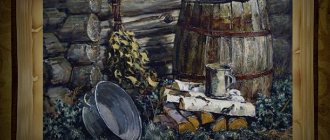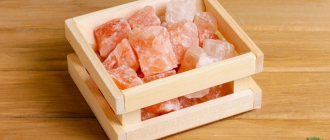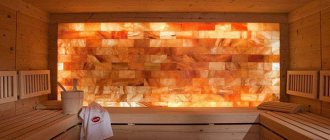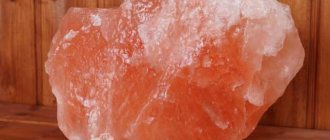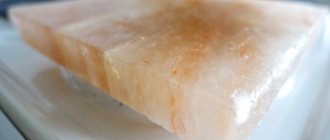A visit to the bathhouse is not only a pleasant pastime, but also a health procedure that helps strengthen the body and cure various diseases. Do you want to increase your health benefits? Himalayan salt is an environmentally friendly substance that has healing properties.
Himalayan bath salt: features and properties
Salt has long been used in alternative medicine. It is believed that it helps cope with many diseases:
- skin diseases;
- high blood pressure;
- allergies;
- diseases of the respiratory system;
- diseases of the musculoskeletal system;
- metabolic disorders;
- nervous disorders, insomnia, etc.
Himalayan salt was created by nature millions of years ago; it is an environmentally friendly substance. The healing effect of salt is determined by its rich chemical composition; it includes more than 85 elements, including: potassium, copper, magnesium, iron, calcium, barium, sodium. With them she saturates the air in the bathhouse. It also contains about 200 chemical compounds.
These substances destroy abnormal molecular compounds in the body, which helps get rid of salt deposits and even reduce sclerosis!
Its use helps relieve chronic fatigue, cure depression and improve mood.
Even beauty salons use Himalayan salt as it helps maintain the beauty and youth of the skin.
But salt, like any other substance, has its contraindications. It is recommended to refrain from using it for people suffering from dermatological, oncological diseases, as well as severe blood diseases.
Application
Pink salt can be used in exactly the same way as regular salt - as an additive to food or as a decoration. There is various information about its beneficial qualities, but they are not proven from a scientific point of view. In addition, increased salt consumption for the purpose of health improvement can have the opposite effect and lead to the development of diseases of the cardiovascular system, stomach and even cancer. In addition, salt retains fluid in the body, which can cause swelling.
The maximum healing effect that can be obtained from visiting a bath with Himalayan pink salt is akin to that achieved from being in the so-called salt caves.
Be that as it may, it should be remembered that the daily need of the human body for sodium chloride in any form is no more than 5 grams (slightly less than one teaspoon).
Pink Himalayan salt is used in cosmetology and cooking. The fact is that slabs made from such salt can withstand significant temperatures - up to 200 0C - thanks to which they can be heated and then used as a regular stove.
People most often try to use bath salt in briquettes when decorating rooms, in particular, saunas and steam rooms.
Himalayan bath: design features
Depending on the iron content in the salt, the tiles can have different shades: from pale pink to deep red, there are also black samples. Such beautiful and bright colors, presented in a wide selection, make salt a good option for decorating a bath.
Himalayan salt is not a cheap pleasure, so not everyone can afford to make all their walls from it; to save money, we recommend using it as decor.
Despite its apparent fragility, this salt material is resistant and durable; it can withstand temperatures up to +500°C. This is explained by the peculiarity of the formation of the rock in the Himalayan mountains, where it was enriched with magma. Salt blocks are made using a special technology, so they can easily withstand heavy loads.
We recommend reading:
How to make drainage in a bathhouse with your own hands
Under the influence of high temperatures, bath salt ionizes the room, creates a unique and pleasant microclimate, disinfects the air, and has a positive effect on the human respiratory, immune and nervous systems.
Salt blocks are used for finishing floors, ceilings and walls. The material has a unique pattern and pleasant texture, which makes it stand out from other finishing materials.
For added beauty, salt walls are often complemented with LED strips; such lighting creates a soft glow and a relaxing atmosphere.
Since salt is a very durable material, it is even suitable for finishing a heater; by the way, this increases its evaporation and, therefore, its effect. But humidity is detrimental to salt material, so it is preferable to use such decor in relaxation rooms or Finnish saunas, where the humidity does not exceed 50%.
Is there a way to safely use salt?
There is no completely safe method, so it is better to refrain from using salts placed on the heater altogether. But if salt is an essential element of your sauna ritual, and you can’t imagine steaming without it, then here are two tips on how to reduce the likelihood of damage to the stove:
- Never place salt directly on the stove. Buy a special stainless steel stand and place salt briquettes or crystals on it. Hang the stand over the stove or place it on it - the main thing is that water with dissolved salt does not fall on the stones or the body of the heater.
- Before each vaping, check the stand to ensure there is no through corrosion or other holes. If there is any damage, replace it.
At the same time, remember that if you decide to use salt even in accordance with these tips, all responsibility for the consequences will fall on you. If the saline solution causes damage to the oven, you will void your warranty. Therefore, carefully weigh the risks; salt may not be so necessary. For example, it can easily be replaced with aromatic mixtures that are safe for sauna stoves, which, as a rule, contain healthy natural essential oils.
Still have questions? Write to us or call - we will definitely give you the most detailed answers. You can contact us by phone 8-800-775-95-19. The call is free within the Russian Federation. Or write to us in the Atelier Saun group on VKontakte.
Best regards, Atelier Saun online store
Installation of Himalayan salt in the bath
Installing salt blocks is similar to laying bricks; making a salt wall with your own hands is quite possible, you just need to follow the instructions.
Step 1. Prepare the surface
It is necessary to clear the base of all building materials. If you are covering wooden beams with salt blocks, they must be treated with coarse sandpaper. If the base is glass, then you need to use fine-grained paper and degrease the surface.
The wall must be completely dry; blocks should not be placed on a wet wall.
Step 2. Prepare materials
It is necessary to choose the adhesive wisely for laying salt blocks, since their durability directly depends on it.
To glue salt bricks, you need to use a special composition - caustic magnesite and magnesium chloride (3:5). To prepare the mixture, you need to dissolve the salt in warm water, then add magnesite. It dries quickly, so the blocks need to be glued together within about 4 hours.
Disadvantages of such a mixture:
- unattractive color;
- the need to do the work very carefully;
- the need to use multi-colored tile adhesive to decorate the seams.
We recommend reading:
Proper ventilation of the bath: principle of operation and main mistakes
Another option is liquid glass, it looks more aesthetically pleasing, but is inferior in strength to the mixture.
You can also fix salt blocks using a special glue created specifically for Himalayan salt. It is odorless and absolutely safe. In addition, it contains antiseptic additives that protect the surface from microorganisms. The glue dries quite quickly, in just 15-20 minutes, so it needs to be prepared in small portions.
The glue is resistant to temperature changes and moisture.
It is necessary to prepare the salt blocks themselves - brush off any dirt and degrease them.
Step 3. Laying salt blocks
Using a notched trowel, apply glue to the wall and the surface of the salt slab to be fastened, the layer thickness should be approximately 1 cm, and lay the block.
It is necessary that the surface is completely dry, so for 20 hours it is necessary to prevent drafts in the room.
It is best to carry out work on laying salt blocks in warm weather.
A sauna with salt blocks looks impressive, especially if there is lighting. In addition, salt helps to improve the health of the body, it will help improve well-being and mood.
Application options
The mineral can be placed next to the walls in a sauna or steam room; it is best to use small pebbles for this. Small crystals can be placed on the heater.
Salt crumbs are used to saturate the air with salt; they are often placed on the floor in salt rooms. It is especially important in recent years to create such premises not only next to the baths, but also directly in them.
Coarse salt in stones can be placed on hot stones in a steam room. If you add a little water to the hot salt stones, you can very quickly saturate the air with beneficial and healing vapors.
You can also use soap made from Himalayan salt in the bath, which helps fight problematic and oily skin. It is known that this mineral has excellent bactericidal properties; soap also allows you to quickly heal wounds and cracks in the dermis. Real soap made from Himalayan salt can help even out skin texture and even help the fair sex in the fight against cellulite.
Products
It is not always the case that it is possible to lay a salt floor or ceiling, partitions or an entire wall. For such cases, you can consider more affordable options. The most convenient and cost-effective way is to place small bowls in the bathhouse and pour mineral into them. You can use both small crystals and pink salt crumbs.
It is believed that when a salt lamp is turned on, the room will be saturated with sodium chloride ions, which means that the room will be safely disinfected and cleaned. In addition to the so-called antiseptic properties, such salt products in the bath normalize blood pressure, relieve fatigue, and also balance the psycho-emotional state.
Be that as it may, a salt lamp is not only a wonderful interior decoration, but also a thing that is credited with a lot of useful properties. Believing in them or not is everyone’s business, but it’s better to check. In any case, if the lamp does not cure the disease, it will be a wonderful decoration for the bathhouse decor.
We also recommend taking a closer look at lamps with corner lampshades. This salt lampshade is most often installed in the corners of the sauna.
If the design will be carried out independently, it is extremely important that it complies with all safety regulations
Finishing
Salt materials for finishing a bath or sauna:
- large blocks for walls;
- tiles, which are an excellent analogue of brick;
- bricks and cubes, which can be used to form walls and partitions.
To maximize all the beneficial properties of salt, it is recommended to lay a couple of salt bricks or slabs on the floors or mount them into the walls during the construction of the bathhouse.
From small tiles of Himalayan salt, craftsmen often create amazing panels that not only have healing properties, but can also be an excellent solution for a bathhouse with a relaxation area. In an illuminated interior, such panels look as if they were made of expensive stone. Attaching them is not difficult, and most importantly, it does not take long. But it is best, of course, to place large panels or even entire salt panels in the steam room, where they will bring great benefits.
You can create any composition or lay out an entire wall using salt bricks. Correctly installing the panel yourself can be very difficult, because in this case you need to have special skills in installation and working with the mineral. However, in order to independently attach a salt panel to the desired surface, we recommend purchasing high-quality glue or liquid glass.
If you don’t want to use glue, you can use glueless fastening of the tiles to the wall. For some, the glue-free method may be more relevant and safe, because it does not use an adhesive composition of unknown origin, which is especially advantageous for a healthy bath.
Today, some companies offer to buy ready-made salt tile panels with all the necessary installation materials. Installing such a decorative element will not be difficult; the main thing is to follow the instructions offered by the manufacturer, and even better, use the services of a professional craftsman who knows how to work with this kind of minerals.
Mineral composition
Table salt and pink Himalayan salt are composed primarily of sodium chloride, but pink contains up to 84 other minerals and trace elements. These include common minerals such as potassium and calcium, as well as lesser known minerals: strontium and molybdenum.
You can see that the kale contains more sodium, but the pink contains more calcium, potassium, magnesium and iron. However, the amount of these minerals in pink Himalayan salt is very small.
They are found in such small quantities that to obtain the recommended daily amount of potassium, you would need 1.7 kg of pink Himalayan salt. Needless to say, this is an unrealistic amount to consume on a daily basis.
For the most part, supplemental minerals are in such small quantities that they are unlikely to provide you with any health benefits, so the benefits in food form are not as obvious as in topical applications.
The principle of operation of salt baths
When Himalayan salt crystals interact with hot water, a powerful compound is formed, which in terms of usefulness and effectiveness can be compared to natural hot springs. Due to the concentration of components vital for the human body in water, bath and sauna salt has a large number of medicinal properties. Thus, using water with a high alkaline content effectively fights viruses.
To better open pores, cleanse and get rid of toxins, use steam and hot water. Thanks to such bath procedures, hydrostatic pressure increases, which significantly improves the quality of blood circulation. Consequently, harmful substances are dissolved and removed from the body, the blood is saturated with oxygen, and nutrients enter the internal organs in greater volumes. There is also an improvement in metabolism and normalization of the gastrointestinal tract.
Rules for conducting therapeutic procedures
The maximum effect and benefits of health procedures in a salt sauna depend on the special conditions of staying in the steam room:
- The humidity of the room in which salt is used should be 53%. A temporary increase in humidity may lead to a decrease in the therapeutic effect;
- The presence of a permanent internal ventilation system in the steam room is mandatory;
- For installation of facing materials, a special mixture based on magnesite and magnesium chloride in proportions of 3:5 is used. Salt is diluted in purified water, then magnesite is added. The resulting mixture takes on a rich chocolate hue. Consumption of the adhesive mixture is 1:1 (1 kg of glue per 1 sq.m. of mineral elements). The glue completely hardens after 5 hours.
The simplest and most accessible way to use a mineral in a bath is to rub a handful of the mineral slightly moistened in water with soft circular movements into the body. Before starting the procedure, it is recommended to steam your body a little by visiting the steam room for 5 minutes.
Salt can be applied to the entire body, except for the face and neck. Next, you need to spend 8 minutes in the steam room, actively breathing the fumes. To get the maximum effect, it is recommended to use a bath broom. In this case, you can achieve a double effect - intense massage with a broom and safe cleansing of the skin.
The mineral can be used for wiping as a water-based solution. To do this, dissolve a glass of the finished mineral in one glass of warm water.
After completing the procedures, it is recommended to replenish your water supply by drinking warm tea, herbal decoction or fruit drink.
Harm
No matter what beneficial effect salt saunas have, like any steam procedures, they have their own restrictions on visiting. Before visiting, they must be taken into account, since if there are contraindications, the harm caused may be significantly greater than the expected benefit.
You should not stay in a salt steam room in the following cases:
- at elevated body temperature;
- during exacerbation of chronic diseases;
- if there are purulent or bleeding wounds on the skin;
- in the presence of cancer;
- for serious mental disorders;
- under the influence of drugs or alcohol;
- in the period after surgery.
- 7 months ago
#salt cave #salt bath #salt sauna #salt room #salt lamp #salt_cave #connection construction
- 7 months ago
- 7 months ago
#salt cave #salt bath #salt sauna #salt room #salt lamp #salt_cave #connection construction
- 7 months ago
#salt cave #salt bath #salt sauna #salt room #salt lamp #salt_cave #connection construction
- 7 months ago
#salt cave #salt bath #salt sauna #salt room #salt lamp #salt_cave #connection construction
The salt sauna is not only healing, but also an indispensable preventive measure, as it helps to increase the body's protective properties. And if you regularly undergo preventive courses of procedures, you don’t have to worry about the peaks of seasonal respiratory diseases. The main thing is to take into account possible contraindications and follow the rules for visiting a salt bath - do not exceed the permissible duration of stay in the steam room and do not overeat before the session.
- Enter the parameters of your cave/sauna/bath or simply leave a request
- We will receive an estimate for your project from each of our contractors
- We will choose the best offer and contact you
- You will get a salt room at the best price
Your promo code: “Your Cave”! Tell it to our employee and the surveyor’s visit will be free for you.
Kinds
Salt is the cheapest means for bathing procedures. Several types of salts can be used in a steam bath:
Stone
The usual rock table salt, which is used by every housewife for cooking. Its peculiarity lies in its fine grinding and possible mineral additives. It is necessary to monitor the composition of the substance: it should not contain fragrances or harmful chemical additives.
Marine
It is large, enriched with elements characteristic of sea water, which means it is very close to the composition of blood and therefore the use of sea salt is very useful. Effective for treating skin diseases, removes toxins, heals wounds, stimulates sweat production.
Himalayan
You can buy it in a specialized store for baths or saunas, in hardware or perfume departments of household stores. It enriches the body with barium and sodium, the properties increase many times when heated.
Important! There are contraindications for use: renal failure, cancer, glaucoma, tuberculosis, blood diseases. It is a valuable mineral formed during centuries of volcanic activity and mined in the Himalayan mountains of the Punjab province of Pakistan.
Salt, which contains more than 90 useful chemical elements, is extracted manually, so it is recognized as one of the most environmentally friendly substances used in everyday life.
It is a valuable mineral formed during centuries of volcanic activity and mined in the Himalayan mountains of the Punjab province of Pakistan. Salt, which contains more than 90 useful chemical elements, is extracted manually, so it is recognized as one of the most environmentally friendly substances used in everyday life.
Depending on the inclusion of iron oxide in the substance, salt is classified into 3 types: pink, red and black. Pink and red are especially popular.
In a Russian steam room or sauna, Himalayan salt can be used in the form of:
- bricks - they are used to lay out small walls in the steam room;
- tiles - cover the walls;
- pebbles (from a pea to a walnut in size) - placed on the stove and sprinkled with water to release steam;
- sand from medium and coarse salt - used to scrub the body or prepare a solution for wiping.
Properties
When used correctly in a bath, Himalayan (pink) salt begins to behave in a special way: the higher the temperature, the brighter its healing and preventive properties are revealed, but the higher the humidity, the faster the salt breaks down and melts quickly (the permissible humidity for it is only 50% ). Therefore, the bathhouse must have good ventilation.
Since the basis of Himalayan salt is sodium chloride (like table salt), its medicinal, cosmetic and preventive properties are the same as sea salt and regular table salt.
But the following features of this substance deserve special attention:
- salt is a humidity stabilizer in the bath - it immediately begins to absorb excess water and replenish the deficiency;
- has a strong antiseptic property - laid out on the floor will not only exfoliate the feet, but will also disinfect the surface;
- is capable of dry ionization of the room - for this it is placed in small wicker containers in the corners of the steam room;
Content
- Himalayan salt: what is it and what makes it unique
- Beneficial properties and healing effects of Himalayan salt
- Contraindications
- Options for using Himalayan salt in baths and saunas
- Salt skin care and accessories
- Himalayan salt interior finishing options
- Adviсe
- Rules for procedures in a bath with Himalayan salt
- Conditions for obtaining the maximum beneficial (therapeutic) effect from visiting a bath with Himalayan salt
[ads-pc-2][ads-mob-2]
Advantages and disadvantages
When the air in the sauna is heated with the required amount of moisture, the salt begins to evaporate and replenish the body with the most important microelements. Thanks to it, the nervous system calms down, toxins are eliminated - the body is completely cleansed. All muscles of the body become toned, blood flow to the extremities improves. In addition to all this, harmful bacteria are destroyed, since salt has an antiseptic effect, and damaged cells are quickly restored.
It has diuretic effects on the body: appetite increases, metabolism improves, and if a hangover is present, its symptoms decrease. Salt vapors have a laxative effect on the intestines and relieve joint pain. Doctors do not doubt its healing properties, so they safely prescribe bath procedures with it.
Indications for this include diseases of the digestive and genitourinary, respiratory and cardiovascular systems, skin rashes from psoriasis, and allergic reactions. Rinsing the mouth with a salt solution relieves irritation and inflammation of the gums. Using compresses eliminates blue bags under the eyes and improves complexion. In addition, salt with a fine structure can be rubbed on a body already heated in a steam room. It is necessary to rub it into the skin with massage movements - not only will a scrubbing effect occur, but also the opening of the pores to replenish the lack of microelements.
Bathing procedures with salt will in no way harm the body, even with frequent use. But to use it for food, there are some restrictions and contraindications that must be adhered to. Salt can have a negative effect on the body of people who have malignant tumors and blood diseases. The use of salt is strictly contraindicated for pregnant women, especially in the last stages, and for people who have renal failure, tuberculosis and varicose veins.
Benefits and harms
Using sauna salt has many benefits. Let's try to figure out why this particular product has recently received the highest ratings.
- Salt relaxes and sets you on the right rhythm. It is with it that sea and ocean air, which has so many healing properties, is associated.
- It's no secret that when steaming, the body produces quite a lot of sweat. Along with it comes the much-needed salt. Having it in the bathhouse will help quickly and quietly replenish the balance.
- Salt helps with skin problems. It disinfects and heals small wounds and scratches well, helps with lichen, dermatitis and other similar diseases. Women especially appreciate this product, since after the procedures the dermis becomes elastic, silky, looks fresh and youthful.
- Bath salt is one of the best supportive agents in the fight against breathing problems. It is often prescribed to those who suffer from asthma. The product also works great against throat ailments.
- Another excellent quality of salt is its ability to relieve pain from joint diseases. If arthritis or rheumatism interfere with living a peaceful life, then visiting a salt bath should be taken as a rule.
If we talk about the dangers of salt for a sauna or bath, then there is practically none.
Doctors do not recommend visiting a salt bath, or even a bath in general, if:
- oncological diseases;
- pregnancy and lactation;
- severe colds and acute respiratory diseases, flu;
- periods of exacerbation of chronic ailments;
- diabetes, epilepsy, poor blood clotting;
- presence of open wounds.
In addition, you need to remember that foods that go well with salt and give an additional positive effect may well be strong allergens. We'll look at them in more detail a little later.
